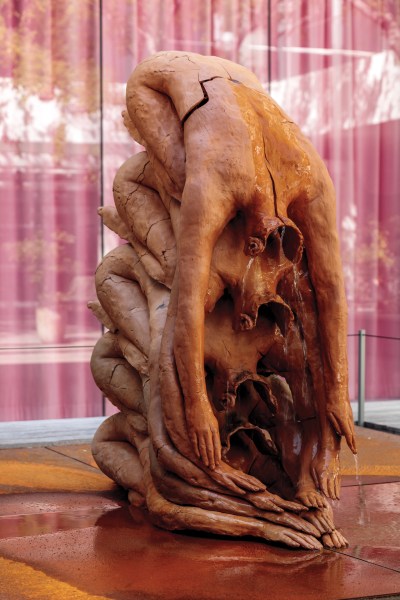Growing up in the ’90s in Yazd, Iran, Roksana Pirouzmand was surrounded by family creativity. Her mother sewed all the family’s clothes, and her grandmother, remembering songs from her childhood, played them on the an oxa Persian drum often used in weddings. Pirouzmand took a similar inclination towards making things with her hands, although she entered high school intending to study science, before forcing her parents to let her attend art school instead.
After high school, Pirouzmand and some former students started an art collective; around 2008, they staged a series of public interventions scattered around the Yazd University of Art and Architecture campus. For her piece, Pirouzmand stood in a pond, goggles covering her face, and attempted to paint a portrait underwater. It ended when the artist asked one of her teachers, who was in the audience, what he thought of this underwater art. He didn’t answer.
“After the first night, [the university] it was like, ‘sorry, you can’t come back here,’” recalls Pirouzmand, sitting in her airy garage studio in Sherman Oaks, California, where she relocated in 2012 through a refugee program for religious minorities. She had never had another experience as dangerous and exciting as that underwater public intervention. “Those performances, even though I wasn’t sure what I was doing … it was so exciting,” she says. This excitement was a constant animator of Pirouzmand’s practice. Between painted ceramics and sculpture in various metals, her works reveal personal and intergenerational stories at the same time, while being fun and playful.

Roksana Pirouzmand: Until Everything Is Dissolved2023.
Josh White’s photo. Courtesy of the artist.
Pirouzmand, who is a Zoroastrian, first lived with his aunt in Valencia, California, after immigrating from Iran. Then, she found herself drawn to the interdisciplinary ethos of nearby CalArts, and ended up pursuing her BFA there, pursuing her interest in performance but also exploring textiles and sculpture. I Feel the Velvet (2015), a work Pirouzmand made while she was still a student, she ushered participants into a gallery space one by one, then dressed them in a skin-tight dress studded with velvet stones. Each time someone wore the 50-pound dress, Pirouzmand sewed on one more stone. “I was thinking about the work of being an artist,” she says. “By putting the weight on the audience … I was distributing this work, in a way.”
Around 2020, Pirouzmand started painting on clay slabs, as the Covid pandemic prevented an audience. Map the pictures first shown in the future, in physical and psychological fields. Soon, a series appeared entitled “I was praying at home while you were dying in the streets” (2022), which imagines figures lying on the ground as if meditating, their long hair pull towards nothingness. These works also contribute to civil unrest in Iran, as does her performance in 2022. Knocking, knocking, rememberingin which Pirouzmand took strands of hair that were attached – through a wall – to terra-cotta chestnuts of her grandmother’s fingers: the tugs caused the fingers to beat caphonously.
Around that time, sculpture began to enter Pirouzmand’s work, but the body is still definitely present. One of her pieces in the latest issue of Made in LA, Until Everything Is Dissolved (2023), a ceramic cast of five headless figures stacked on top of each other in an attitude of submission. The water flowing down the piece drenched and decayed the figures around the show took place, their bodies split as their prayers seemed to give way to begging.
#Controversial #Performance #Roksana #Pirouzmand #Takes #Sculpture #Body #Remains #Permanently #Present